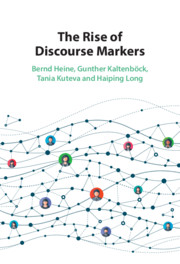Book contents
- The Rise of Discourse Markers
- The Rise of Discourse Markers
- Copyright page
- Dedication
- Contents
- Tables
- Preface
- Abbreviations
- 1 The Development of Discourse Markers
- 2 Concepts of Analysis
- 3 English Discourse Markers
- 4 French Discourse Markers
- 5 Japanese Discourse Markers
- 6 Korean Discourse Markers
- 7 Discourse Markers in Language Contact
- 8 Discussion
- 9 Conclusions
- References
- Language Index
- Author Index
- Subject Index
8 - Discussion
Published online by Cambridge University Press: 11 June 2021
- The Rise of Discourse Markers
- The Rise of Discourse Markers
- Copyright page
- Dedication
- Contents
- Tables
- Preface
- Abbreviations
- 1 The Development of Discourse Markers
- 2 Concepts of Analysis
- 3 English Discourse Markers
- 4 French Discourse Markers
- 5 Japanese Discourse Markers
- 6 Korean Discourse Markers
- 7 Discourse Markers in Language Contact
- 8 Discussion
- 9 Conclusions
- References
- Language Index
- Author Index
- Subject Index
Summary
This chapter is reserved for issues that surfaced in previous chapters but for some reason or other could not be discussed there in any detail. On the one hand, the chapter looks at the framework outlined in Chapter 2 from a wider perspective. It is argued that the presence of two contrasting mechanisms is suggestive of a dual process model of the kind described in work on discourse analysis, neurolinguistics, and social psychology. On the other hand, the chapter shows that whereas the pathways leading to grammaticalization are highly constrained, those leading to the rise of discourse markers are almost unlimited. Further topics discussed in the chapter concern the structure of constituent anchored discourse markers and the role played by imperative forms in the rise of discourse markers. Finally, the chapter also looks into the role of a more marginal category of discourse-structuring devices, namely that of fillers or "hesitation markers."
- Type
- Chapter
- Information
- The Rise of Discourse Markers , pp. 236 - 266Publisher: Cambridge University PressPrint publication year: 2021

